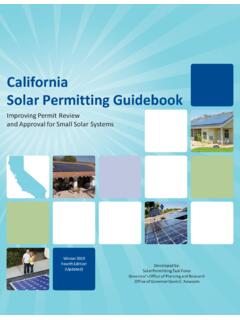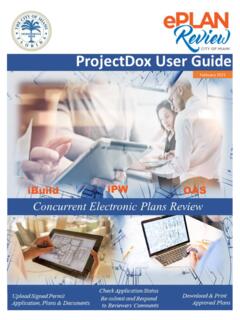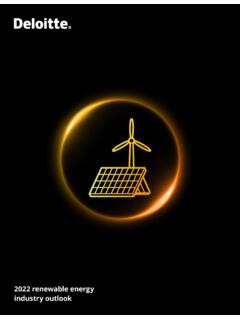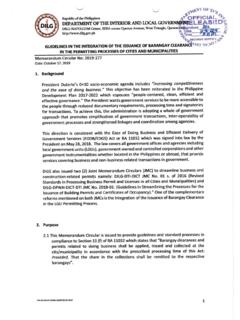Transcription of CALIFORNIA GOVERNOR’S OFFICE OF BUSINESS AND …
1 Electric Vehicle Charging Station permitting GuidebookCalifornia Governor s OFFICE of BUSINESS and Economic Development (GO-Biz)JULY 2 019 CALIFORNIA GOVERNOR S OFFICE OF BUSINESS AND ECONOMIC DEVELOPMENTE lectric Vehicle Charging Station permitting GuidebookCALIFORNIA GOVERNOR S OFFICE OF BUSINESS AND ECONOMIC DEVELOPMENTLead Authors:Tyson Eckerle Gia Brazil VacinPublished July 2019 | First EditionElectronic Version Available: Major Contributions From: Arthur Shemitz Taylor Jones Kielan RathjenLayout and Production: CALIFORNIA Department of General Services OFFICE of State PublishingAcknowledgmentsThis Guidebook reflects the input and feedback received from several federal, state, and local agencies, along with a host of industry and non-profit electric vehicle charging station experts. The Governor s OFFICE of BUSINESS and Economic Development would like to extend our deep appreciation to the groups listed below, as well as to those we inadvertently omitted.
2 Adopt a Charger; the Bay Area Air Quality Management District; CALIFORNIA Electrification Transportation Coalition; CALIFORNIA state agencies: Air Resources Board, Building Standards Commission, Coastal Commission, Department of Corrections and Rehabilitation, Department of General Services, including the Division of the State Architect, Energy Commission, Environmental Protection Agency, Housing and Community Development, State Transportation Agency, Public Utilities Commission; Center for Sustainable Energy; Chargepoint; Cities: Burbank, Encinitas, Half Moon Bay, Menlo Park, Pasadena, Sacramento, San Anselmo, San Bernardino, San Diego, San Francisco, San Jose, Santa Monica; Counties: Sacramento, San Francisco, Los Angeles, Tuolumne; Contra Costa Transportation Authority; Electrify America; EVgo; Electric Vehicle Charging Association; Envision Solar; Energy Solutions; EV Alliance; EV Charging Pros; Envoy; Frontier Energy; Greenlots; Gladstein, Neandross & Associates; the Governor s OFFICE of Planning and Research; the Luskin Center for Innovation; Los Angeles Department of Water and Power; Los Angeles County; Paired Power; Pacific Gas & Electric; Plug-in America; Powertree; Recolte Energy; Sacramento Municipal Utility District; San Diego Association of Governments; San Diego Gas and Electric; Southern CALIFORNIA Air Quality Management District; Southern CALIFORNIA Association of Governments; Southern CALIFORNIA Edison; Tesla; Thor Trucks; Volta; US Environmental Protection Agency; Veloz; and , several publications formed the foundation of this guidebook.
3 A list of select resources can be found at the end of this errors in the Guidebook are the sole responsibility of the Governor s OFFICE of BUSINESS and Economic Development. With that in mind, we are always looking for ways to improve the resources we create. Please send suggestions to Images courtesy of the Bay Area Air Quality Management District, EVgo and the CALIFORNIA Energy CommissionTable of Contents Executive Summary ..viPart 1: Setting the PEVs in CALIFORNIA Path to Scope and Purpose ..3 Part 2: Planning and Site How Station Developers Select Sites ..7 Filtering Potential Locations ..7 Securing a Specific Charging Layout .. How AHJs Plan and Support Station for Charging Stall Requirements and Charger Infrastructure through Building Standards ..13 Curbside Cooperation between Station Developers and 3: Understanding the Permit State Permit streamlining Requirements (AB 1236).
4 20 Additional permitting Best Practices ..24 Preparing a Permit Application ..27 What to Include in Your Common 4: Accessibility ..31 Background .. 31 Federal s Early Process and Need for Specific Requirements ..32 Regulation Development ..32 Regulatory Requirements (High-Level Summary) ..33 Scoping Provisions ..33 Technical Requirements ..35 Path of Travel Improvements and Accessible Route ..39 Exceptions .. 41 Working Together to Achieve Challenges ..42 Implementation Lessons & Updating the Code ..43 Part 5: Connecting to the Grid ..45 Understanding Grid Connection ..46 Timeline for Communicating with Your Major Utility Grid Connection Gas & CALIFORNIA Edison ..48 San Diego Gas & Electric ..48 Los Angeles Department of Water and Power ..49 Sacramento Municipal Utility District ..50 Opportunities to Streamline Connection to the Grid ..50 Part 6: Construction, Commissioning, and Operation.
5 53 Construction, Installation, and Review ..53 Commissioning and Operation ..54 Weight and Measures ..54 Part 7: Looking 8: Definitions and Additional Key Terms and Definitions ..58 ZEV Readiness Scorecard ..60 Electric Vehicle Charging Station streamlining All-Star Checklist ..62 Planning for Zero Emission Application Best Practices ..62 Connecting to the Grid Best AB 1236, Chiu Local ordinances: electric vehicle charging stations ..64VI ELECTRIC VEHICLE CHARGING STATION permitting GUIDEBOOKC alifornia is at the beginning of a massive transformation from internal combustion to zero emission vehicles. The question is not if we will complete the transition, the question is when. When matters. Timing pivots on our collective ability to streamline zero emission vehicle infrastructure development. CALIFORNIA s transportation sector remains the single largest contributor of emissions for both greenhouse gases and health impacting criteria pollutants.
6 Nearly 3 million Californians suffer from asthma and climate change impacts are already worse than ,2 The solution is to reduce drive times and distances, and eliminate emissions from the transportation system. Each zero emission vehicle (ZEV) that replaces the function of an internal combustion vehicle brings us closer to the long-term goal of a carbon-neutral transportation reach true market potential as quickly as possible, CALIFORNIA should be the most straightforward place in the country to install market enabling ZEV charging and fueling infrastructure. The goal of this guidebook is to hasten the transition to plug-in electric vehicles (PEVs) by simplifying the deployment of electric vehicle charging stations. We aim to accomplish this by creating a shared foundation of understanding for how cities, counties, and developers can work together to streamline the planning, permitting , installation, and ongoing operation of electric vehicle charging stations and supporting equipment.
7 The guide is comprised of eight parts. Throughout the guidebook, we include three layers of information: context, requirements, and recommendations or best practices. We dive into the greatest depth in four key areas: planning, permitting , accessibility, and grid connection, and tie recommendations together with a ZEV Readiness Scorecard and checklists at the end of the document. The best-case scenario includes a local government committed to strong building standards and electric vehicle related planning; a streamlined and transparent permitting process, inclusive of applying an informed approach to ensuring accessibility; a predictable connection to the grid, when applicable; and a well-informed electric vehicle charging station developer who has benefited from easily accessible resources. Planning: Local authorities having jurisdiction can create a ZEV future by incorporating ZEV infrastructure into city planning initiatives and adopting voluntary building codes to ensure supporting infrastructure is installed at the least costly point in time during construction.
8 Clear planning direction can help station developers with their project proposals, just as understanding how station developers choose sites can help inform permitting : CALIFORNIA s electric vehicle charging station permit streamlining law (AB 1236 Statutes of 2015, Chapter 598) was enacted to address mutual frustration: electric vehicle charging station providers wanted to speed the permitting process; and cities and counties often needed better information from applicants and/or a directive to create streamlined help address these frustrations, AB 1236 establishes permitting process and communication requirements for cities and counties essentially putting best Executive Summary1 State of the Air, 2018. American Lung CALIFORNIA s Fourth Climate Change Executive Order B-55 Hydrogen and fuel cell electric vehicles, which are a complimentary zero emission vehicle technology, are addressed in the companion Hydrogen Station permitting VEHICLE CHARGING STATION permitting GUIDEBOOK VIIpractices into statute.
9 However, to meet CALIFORNIA s ZEV goals, we need communities to implement AB 1236 and improve upon its requirements by sharing on-the-ground learnings and best practices. The electric vehicle charging industry continues to rapidly evolve and ultimate success hinges on ongoing dialogue and process : As a market leader, CALIFORNIA is also the first state in the nation to develop electric vehicle charging station accessibility regulations to define compliance with the broad responsibility under the federal Americans with Disabilities Act. The State developed these regulations to provide certainty for cities, charging station providers, and property owners to help balance co-equal goals of deploying infrastructure and ensuring broad access to services. Implementation of these rules often comes down to local interpretation. This guide provides the context for the development of the accessibility regulations and suggests resources to help local building officials and station developers deliver projects that benefit all ZEV drivers.
10 Grid connection: Electric vehicle charging stations are one of many grid-connected services vying for utility attention. This guide explores the preferred processes for CALIFORNIA s five largest utilities, all of which are committed to electrifying addition to the above subject areas, the guide addresses the construction and commissioning of stations and looks forward to a CALIFORNIA with normalized electric vehicle charging station development processes and ubiquitous zero emission vehicles. To get there, CALIFORNIA has many advantages. We have the most robust ZEV market in the country the most charging and fueling stations, the most vehicles, and the most experienced city and county planners, building officials, and local leaders. While ultimate success is not inevitable, experience has shown that just one dedicated individual within a local government can catalyze efforts that turn their city or county into a model ZEV enabling community.







